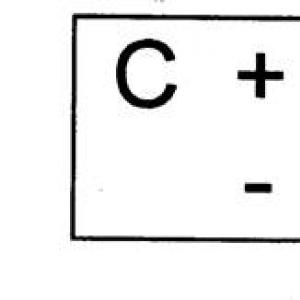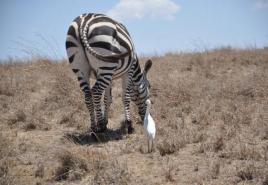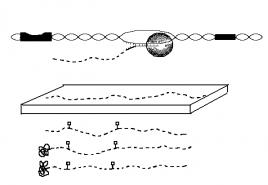Maturation (RNA processing). processing, splicing
This is a set of processes that ensure the transformation of synthesized RNA (RNA transcript) into functionally active RNA (mature RNA) that can be used in protein synthesis. The RNA transcripts themselves are not functionally active. The process is characteristic of eukaryotes.
As a result of processing, the structure and chemical organization of RNA changes. The RNA transcript prior to the formation of mature RNA is called pro-mRNA(or depending on the type of RNA - pro-tRNA, pro-rRNA), i.e. RNA precursor. Almost all RNA transcripts of eukaryotes and prokaryotes (excluding prokaryotic mRNA) are being processed. The transformation of an RNA transcript into mature RNA begins in the nucleus, when RNA synthesis has not yet been completed and it has not separated from DNA. Depending on the mechanisms, several stages of RNA maturation are distinguished.
Interaction of pro-mRNA with protein.
Methylation of pro-mRNA.
Capping the 5' end.
Polyadenylation.
Splicing.
The graphical sequence of stages is shown in Figure 58. It should be noted that in living organisms all of the above processes run parallel to each other.
A. Interaction of pro-mRNA with protein.
In bacteria, even before the end of transcription 5', the end of the transcript immediately connects to the ribosome and the mRNA is included in the translation. Therefore, practically no modification is required for bacterial mRNA. In eukaryotes, the synthesized transcript leaves the nucleus, enters the cytoplasm, and there it joins the ribosome. On its way, it must be protected from accidental encounters with strong reagents and, at the same time, be accessible to processing enzymes. Therefore, the RNA transcript immediately interacts with the protein as it is elongated. An analogy is appropriate here - the RNA transcript is located on the protein as on an operating table, it is fixed by chemical bonds, and at the same time modification sites become available in it. The RNA associated with a protein is called a ribonucleoprotein (informosome). In this form, the transcript is located in the nucleus. When leaving the nucleus, some RNAs continue to remain in combination with the protein, while others leave the complex and take part in translation.
b. Methylation of pro-mRNA.
Most often occurs in bacteria that have a special defense mechanism against foreign
DNA (viral, phage). This apparatus consists of a number of enzymes that cut foreign DNA or RNA at certain sites in which a specific nucleotide sequence is located. Enzymes are called restrictases. It is clear that one's own newly synthesized RNA transcript can also be attacked by restriction enzymes. To prevent this from happening, special enzymes called methylases, methylate their own RNA transcript at sites that can be cut by their own enzymes. In eukaryotes, the RNA transcript is less methylated.
 Promoter Terminator
Promoter Terminator
Transcription
Pro-mRNA fixi-Protein
torn on protein
Pro-mRNA methylation
Capping of pro-mRNA
Rice. 58. Scheme of the main points of processing.
V. Capping 5' end.
Consists of chemical and conformational change
5'end of the synthesized RNA. Capping occurs at the time of RNA synthesis, even before its separation. The process consists in attaching special chemicals to the free end of the pro-RNA, which change the conformation of the terminal region. Capping is necessary to initiate the translation process.
Special enzymes attach to the 5'end of the pro-mRNA GDP (guanosine diphosphate) and then methylate it.
5' pro-mRNA
CH 3
CEP = HDF + CH 3
Fig.59. The structure of the CEP at the 5'end of eukaryotic pre-mRNA.
CEP functions.
Initiates protein synthesis.
Protects pro-mRNA from decay.
Involved in the removal of introns.
d. Polyadenylation.
This is the process of attaching 100-200 adenylic acid residues to the 3' end of the pro-mRNA. These residues are called poly-A sequences (poly-A tails). Not all pro-mRNAs undergo polyadenylation. For example, molecules of all types of histones do not contain poly-A sequences. Polyadenylation prevents mRNA from being destroyed.
The growing mRNA chain has a special nucleotide sequence (AAAAAA). A special enzyme (polyA polymerase) finds this combination of nucleotides, cuts the pro-mRNA in this place and forms a polyadenyl tail.
The value of poly-A sequences:
Facilitate the release of mRNA from the nucleus into the cytoplasm.
Protect mRNA from destruction.
Recently, another interesting property of poly-A sequences has been revealed - they are involved in the termination of pro-mRNA synthesis. RNA polymerase, forming the AAUAAAA sequence in pro-mRNA, receives a signal about the completion of the synthesis of the RNA transcript. But the synthesis does not stop immediately. It stops completely after RNA polymerase encounters a specific nucleotide sequence on the DNA template strand (it is different for different genes), which gives the final signal to stop RNA synthesis.
GTP PolyA - sequence
rArArArArArArArA-ON
CH 3
CEP = GTP + CH 3
Rice. 60. The structure of the CEP at the 5'end of eukaryotic pro-mRNA and the polyadenyl sequence at the 3'end of pro-mRNA.
e. Splicing.
IN The RNA transcript contains a certain number of nucleotide sequences that were necessary for the successful completion of translation and subsequent modification of the transcript (capping, polyadenylation, etc.). To perform the main role of RNA in the cytoplasm - translation, these sequences will not only have no functional significance, but may interfere with the normal course of protein synthesis. Therefore, the cell provides a mechanism for the release of the primary transcript from a number of sequences that are not critical in translation.
These sequences are primarily introns.
The gene from which pro-mRNA was transcribed contains coding and non-coding sequences. The coding sequences of a gene determine the amino acid and their sequence in the protein. Non-coding sequences do not have this property. The coding and non-coding sequences in a gene alternate, and their number depends on the individual genes. The primary transcript also contains coding and non-coding sequences. This organization of genes and pro-RNA is characteristic of eukaryotes. Non-coding pro-mRNA sequences are called introns, and the coding exons. The length of introns can be from 50 to 12,000 nucleotides. Gene starts and
ends with an exon. The discontinuous structure of the gene is characteristic of most eukaryotes. Introns can contain all types of RNA - mRNA, tRNA, rRNA.
The entire set of exons (coding proteins) in the human genome occupy only 1.1 - 1.4%. The average human gene contains 9 introns. As you simplify
organization of organisms, the total value of their exons increases (for example, in bacteria it is 86%).
A multicomponent complex takes part in the excision of introns from the RNA transcript and the fusion of the remaining exons. Its main components are small nuclear RNA (snRNA) and enzyme proteins.
In general, the complex is called small nuclear ribonucleoproteins, snRNPs orspliosome . The process itself is quite complicated and consists of several stages (see Fig. 58).
1. Shapingspliosomes . Fragments of protein and snRNA are attached to the beginning and end of the intron (Fig. 56, E) forming a spliosome. (Fig. 56, E) Attachment of the snRNP complex (Fig. 56, F).
 Exon 1 Intron Exon 2
Exon 1 Intron Exon 2
A loop
intron cut out
Rice. 61. Scheme of splicing (explanation in the text).
Approximation of neighboring exons, due to the formation of an intron loop. Cutting at the exon-intron boundary and connecting neighboring (first and second) exons (Fig. 56, C).
Removal and destruction of the loop and spliosome (Fig. 56, D, G).
It should be noted that if the intron is damaged (mutated), splicing may not be completed, the intron may not be excised, and the end product, mRNA, will carry nucleotide sequences that are unusual for it. It is clear that this can lead to disruption of translation and exclusion of a certain protein from the metabolism.
e. Alternative splicing.
This type of splicing occurs when the same gene is expressed in different tissues.
Its essence is that the same section of a gene in different tissues can act as an intron and an exon. This leads to the formation of different mRNAs that encode proteins with different enzymatic activities.
So in the cells of the thyroid gland, the hormone calcitonin is synthesized. It inhibits the release of calcium from bones. The gene that controls calcium synthesis
The gene that controls calcitonin
uh and uh and uh and uh and uh
1 2 3 4 5 6
uh and uh and uh and uh and uh
pro-mRNA
1 2 3 4 5 6
in the thyroid gland in the brain cells
mRNA
1 2 3 4 1 2 3 5 6
Calcitonin Calcitonin-like protein
Fig.62. Alternative splicing of calcitonin and calcitonin-like protein.
cytonin, consists of 6 exons, the primary transcript of this gene (pro-mRNA) also consists of 6 exons (Fig. 62). A mature mRNA containing 4 exons - 1,2,3,4 is formed from the primary transcript. Exons #5 and 6 were read as introns and excised. Based on this and RNA, calcitonin is synthesized. In brain cells, from the primary transcript containing 6 exons, a mature mRNA is formed, consisting of 5 exons - 1,2,3,5,6. The fourth exon was excised as an intron. Such mRNA controls the synthesis of a calcitonin-like protein responsible for taste perception.
Another geneIcarus(named after the legendary Icarus) is able to provide, through alternative splicing, the synthesis of 6 different polypeptides. In addition, polypeptides form between themselves in the cell about 20 different ensembles of the same polypeptides or different ones.
Violation of the splicing mechanism can lead to pathological conditions that are collectively called thalassemia. These include diseases associated with partial or complete suppression of the synthesis of one of the hemoglobin chains (α- or β-chains). For example, diseases associated with a lack of synthesis of the β-chain of hemoglobin can result from mutations in two regions of the gene encoding the β-chain - in the site responsible for polyadenylation and in one of the introns. In the first case, the process of formation of the polyadenyl tail is disrupted and an inferior β-chain of hemoglobin is formed. In the second case, the spliosome is unable to cut out the damaged intron, and the mature hemoglobin β-chain mRNA is not formed. In any case, the normal function of red blood cells will be significantly impaired.
MZ. Processing (or RNA maturation) is the process of converting newly synthesized, inactive RNA (pro-mRNA) into functionally active RNA. The process is associated with structural and chemical modifications of pro-mRNA. Occurs in the nucleus until the release of RNA into the cytoplasm. It consists of several stages: attachment of pro-mRNA to a protein, methylation of some bases, marking of one of the ends, polyadenylation of the other (opposite) end, excision of introns and stitching of exons. The last two processes are called splicing.
Questions for exams.
1. How do enzymes determine most of the places where there is damage to the DNA molecule?
ANSWER. In most cases, local denaturation occurs at the site of damage to the DNA molecule. It is determined by enzymes.
2. What happens at the site of damage to the DNA molecule?
ANSWER. Local denaturation occurs at the site of injury.
3. On the basis of what do repair enzymes restore the necessary sequence of nucleotides at the site of damage to one DNA strand?
ANSWER. Based on the principle of complementarity to the nucleotides of the opposite section of the DNA strand.
4. On the basis of what does DNA polymerase correctly fill gaps in a damaged DNA strand with nucleotides?
ANSWER. Based on the principle of complementarity of the nucleotides of the built-up chain to the nucleotides of the opposite strand.
5. What type of repair is carried out by an enzyme that is activated by a photon?
ANSWER. Photoreactivation.
6. What enzyme carries out repair using the energy of the sun?
ANSWER. Photolyase.
Which enzyme is directly involved in the synthesis of the RNA molecule?
ANSWER. DNA-dependent RNA polymerase or RNA polymerase.
List the periods of transcription.
ANSWER. Initiation, elongation, termination.
What are the components of the initiation complex during transcription?
ANSWER. From a special protein deposited on the promoter, RNA polymerase and transcription factors.
9. What is the name of the DNA region where the initiation complex is formed during transcription?
ANSWER. on the promoter.
10. What is the name of the nucleotide sequence in prokaryotes, which is determined by a special protein that precipitates on the promoter during the period of transcription initiation?
ANSWER. Block Pribnov.
11. What is the name of the nucleotide sequence in eukaryotes, which is determined by a special protein that precipitates on the promoter during the period of transcription initiation?
ANSWER. TATA box.
12. Where in the DNA molecule is the Pribnov block located in prokaryotes?
ANSWER. on the promoter.
13. Where in the DNA molecule is the TATA box located in eukaryotes?
ANSWER. on the promoter.
14. What is the name of the enzymatic complex that forms the transcriptional eye?
ANSWER. initiator complex.
15. What is the name of the section of the DNA molecule from which RNA synthesis begins?
ANSWER. Starting point, transcription start site.
16. Name the nucleotides that are in the terminator and possibly participate in the termination of transcription.
ANSWER. G, C.
17. Name the secondary structure in the terminator, which may be involved in the termination of transcription,
ANSWER. Hairpin.
18. What are the names of the codons located in the terminator and possibly involved in the termination of transcription.
ANSWER. Nonsense (nonsense) codons.
It is this stage that distinguishes the implementation of the available genetic information in such cells as eukaryotes and prokaryotes.
Interpretation of this concept
Translated from English, this term means "processing, processing." Processing is the process of formation of mature ribonucleic acid molecules from pre-RNA. In other words, this is a set of reactions that lead to the transformation of primary transcription products (pre-RNA of different types) into already functioning molecules.
As for the processing of p- and tRNA, it most often comes down to cutting off excess fragments from the ends of the molecules. If we talk about mRNA, then it can be noted that in eukaryotes this process proceeds in many stages.
So, after we have already learned that processing is the transformation of a primary transcript into a mature RNA molecule, it is worth moving on to considering its features.
The main features of the concept under consideration
These include the following:
- modification of both the ends of the molecule and RNA, in the course of which specific nucleotide sequences are attached to them, showing the place of the beginning (end) of translation;
- splicing - cutting off non-informative ribonucleic acid sequences that correspond to DNA introns.
As for prokaryotes, their mRNA is not subject to processing. It has the ability to work immediately after the completion of the synthesis.
Where does the process in question take place?
In any organism, RNA processing takes place in the nucleus. It is carried out by means of special enzymes (their group) for each individual type of molecule. Translation products such as polypeptides that are directly read from mRNA can also be processed. The so-called precursor molecules of most proteins - collagen, immunoglobulins, digestive enzymes, some hormones - undergo these changes, after which their real functioning in the body begins.
We have already learned that processing is the process of forming mature RNAs from pre-RNAs. Now it is worth delving into the nature of ribonucleic acid itself.
RNA: chemical nature
It is a copolymer of pyrimidine and purine ribonucleitides, which are connected to each other, in the same way as in DNA, by 3' - 5'-phosphodiester bridges.

Despite the fact that these 2 types of molecules are similar, they differ in several ways.
Differences between RNA and DNA
Firstly, ribonucleic acid has a carbon residue, which is adjacent to pyrimidine and purine bases, phosphate groups - ribose, while DNA has 2'-deoxyribose.
Secondly, the pyrimidine components also differ. Similar components are the nucleotides of adenine, cytosine, guanine. RNA contains uracil instead of thymine.

Thirdly, RNA has a 1-stranded structure, while DNA is a 2-stranded molecule. But in the ribonucleic acid chain there are regions with opposite polarity (complementary sequence), due to which its single chain is able to fold and form "hairpins" - structures endowed with 2-helix characteristics (as shown in the figure above).
Fourthly, in view of the fact that RNA is a single strand, which is complementary only to the 1st of the DNA strands, guanine does not have to be present in it in the same content as cytosine, and adenine - like uracil.
Fifth, RNA can be hydrolyzed with alkali to 2', 3'-cyclic diesters of mononucleotides. The role of an intermediate product in hydrolysis is played by 2', 3', 5-triester, which is incapable of formation in the course of a similar process for DNA due to the absence of 2'-hydroxyl groups in it. Compared to DNA, the alkaline lability of ribonucleic acid is a useful property for both diagnostic and analytical purposes.

This sequence is complementary to the gene chain (coding) from which the RNA is “read”. Because of this property, a ribonucleic acid molecule can specifically bind to a coding strand, but is unable to do so with a non-coding DNA strand. The RNA sequence, except for the replacement of T with U, is similar to that of the non-coding strand of the gene.
RNA types
Almost all of them are involved in such a process as the following types of RNA are known:
- Matrix (mRNA). These are cytoplasmic ribonucleic acid molecules that act as templates for protein synthesis.
- Ribosomal (rRNA). This is a cytoplasmic RNA molecule that acts as structural components such as ribosomes (an organelle involved in protein synthesis).
- Transport (tRNA). These are molecules that take part in the translation (translation) of mRNA information into a sequence of amino acids already in proteins.
A significant part of RNA in the form of 1st transcripts, which are formed in mammalian cells, is subject to degradation in the nucleus and does not play an informational or structural role in the cytoplasm.
In human cells (cultivated), a class of small nuclear ribonucleic acids was found that are not directly involved in protein synthesis, but affect RNA processing, as well as the overall cellular "architecture". Their sizes vary, they contain 90 - 300 nucleotides.
Ribonucleic acid is the main genetic material in a number of plant and animal viruses. Some RNA viruses never go through the same RNA-to-DNA stage. But still, many animal viruses, for example, retroviruses, are characterized by reverse translation of their RNA genome, directed by RNA-dependent reverse transcriptase (DNA polymerase) with the formation of a 2-stranded DNA copy. In most cases, the emerging 2-stranded DNA transcript is introduced into the genome, further providing the expression of viral genes and the production of the latest copies of RNA genomes (also viral).
Post-transcriptional modifications of ribonucleic acid
Its molecules synthesized with RNA polymerases are always functionally inactive and act as precursors, namely pre-RNA. They are transformed into already mature molecules only after they have passed the corresponding post-transcriptional modifications of RNA - the stages of its maturation.
The formation of mature mRNA begins during the synthesis of RNA and polymerase II at the elongation stage. Already to the 5'-end of the gradually growing RNA strand is attached by the 5'-end of GTP, then the orthophosphate is cleaved off. Further, guanine is methylated with the appearance of 7-methyl-GTP. Such a special group, which is part of the mRNA, is called a "cap" (hat or cap).
Depending on the type of RNA (ribosomal, transport, template, etc.), precursors undergo various sequential modifications. For example, mRNA precursors undergo splicing, methylation, capping, polyadenylation, and sometimes editing.

Eukaryotes: general characteristics
The eukaryotic cell is the domain of living organisms, and it contains the nucleus. In addition to bacteria, archaea, any organisms are nuclear. Plants, fungi, animals, including the group of organisms called protists, are all eukaryotic organisms. They are both 1-celled and multicellular, but they all have a common plan of the cellular structure. It is generally accepted that these so dissimilar organisms have the same origin, which is why the nuclear group is perceived as a monophyletic taxon of the highest rank.
Based on popular hypotheses, eukaryotes arose 1.5 - 2 billion years ago. An important role in their evolution is given to symbiogenesis - the symbiosis of a eukaryotic cell that had a nucleus capable of phagocytosis and bacteria swallowed by it - the precursors of plastids and mitochondria.
Prokaryotes: general characteristics
These are 1-cell living organisms that do not have a nucleus (formed), the rest of the membrane organelles (internal). The only large circular 2-stranded DNA molecule that contains the bulk of the cellular genetic material is one that does not form a complex with histone proteins.
Prokaryotes include archaea and bacteria, including cyanobacteria. Descendants of non-nuclear cells - eukaryotic organelles - plastids, mitochondria. They are subdivided into 2 taxa within the domain rank: Archaea and Bacteria.
These cells do not have a nuclear envelope; DNA packaging occurs without the involvement of histones. The type of their nutrition is osmotrophic, and the genetic material is represented by one that is closed in a ring, and there is only 1 replicon. Prokaryotes have organelles that have a membrane structure.
The difference between eukaryotes and prokaryotes
The fundamental feature of eukaryotic cells is associated with the presence of a genetic apparatus in them, which is located in the nucleus, where it is protected by a membrane. Their DNA is linear, associated with histone proteins, other chromosomal proteins that are absent in bacteria. As a rule, they contain 2 nuclear phases. One has a haploid set of chromosomes, and subsequently merging, 2 haploid cells form a diploid cell, which already contains the 2nd set of chromosomes. It also happens that during subsequent division, the cell again becomes haploid. This kind of life cycle, as well as diploidy in general, is not characteristic of prokaryotes.
The most interesting difference is the presence of special organelles in eukaryotes, which have their own genetic apparatus and reproduce by division. These structures are surrounded by a membrane. These organelles are plastids and mitochondria. In terms of vital activity and structure, they are surprisingly similar to bacteria. This circumstance prompted scientists to think that they are the descendants of bacterial organisms that entered into symbiosis with eukaryotes.
Prokaryotes have few organelles, none of which are surrounded by a 2nd membrane. They lack the endoplasmic reticulum and lysosomes.
Another important difference between eukaryotes and prokaryotes is the presence of the phenomenon of endocytosis in eukaryotes, including phagocytosis in most groups. The latter is the ability to capture by means of confinement in a membrane bubble, and then digest various solid particles. This process provides the most important protective function in the body. The occurrence of phagocytosis is presumably due to the fact that their cells are of medium size. Prokaryotic organisms, on the other hand, are incommensurably smaller, which is why in the course of eukaryotic evolution, a need arose associated with supplying the cell with a significant amount of food. As a result, the first mobile predators arose among them.

Processing as one of the stages of protein biosynthesis
This is the second step that starts after transcription. Protein processing occurs only in eukaryotes. This is mRNA maturation. To be precise, this is the removal of regions that do not code for a protein, and the addition of controls.

Conclusion
This article describes what processing is (biology). It also tells what RNA is, lists its types and post-transcriptional modifications. The distinctive features of eukaryotes and prokaryotes are considered.
Finally, it is worth recalling that processing is the process of formation of mature RNA from pre-RNA.
rRNA processing: cutting of the primary transcript, methylation, splicing. In eukaryotes, all rRNAs are synthesized as part of a single transcript. It is cut by exo and endonucleases into mature sRNAs. The precursor contains 18, 5.8, 28S rRNA and is called 45S RNA. rRNA processing requires the participation of snRNA. In some organisms, the 28S RNA precursor contains inserts/intrans, which are removed as a result of processing and RNA fragments are fused as a result of splicing.
The upprokaryotic rRNA precursor contains 16, 23, 5S rRNA + several tRNA precursors. The 3 and 5' ends are brought together by complementary adjacent base pairs. This structure is cleaved by RNase III. The remaining ribonucleotides are cut off by exonucleases/trimming. The processing of the 5' end of tRNA is carried out by RNase, and the 3' end is processed by RNase D.tRNA nucleotidyl transferase completes the CCA tail.
In eukaryotes, the tRNA precursor contains an intron, it is not limited to conserved sequences, and is built into the anticodon loop. Requires removal of introns and splicing. Splicing is based on the recognition of the secondary structure of tRNA and requires the participation of enzymes with nuclease (RNA is split at the exon-intron boundary from both sides) and ligase (cross-linking of free 3 and 5'-cones) activity. Upon release, the intronatRNA folds into its normal structure.
mRNA processing. Modification of the 5' end (capping). Modification of the 3'-end (polyadenylation). Splicing of primary mRNA transcripts, spliceosome. Autosplicing. Alternative splicing.
Pre-mRNA processing The eukaryote consists of several stages:
1. Cutting off extra long tail sequences.
2. Attachment to the 5'-end of the CEP sequence, in which 7-methylguanosine is necessarily present, from which the CEP begins. Next is 1-3 methylated ribonucleotides. It is assumed that CEP is necessary for the stabilization of mRNA, preventing it from cleavage by 5'-exonucleases, and is also recognized by the ribosome. The formation of a CEP makes it possible to undergo splicing.
3. Excision of introns and splicing exons.
As a rule, splicing involves special ribonucleoprotein particles (RNPs) - small nuclear RNPs (snRNPs), which include uracil-rich snRNAs designated U1-U6 (sometimes called ribozymes) and numerous proteins. These RNP particles at the junctions of introns and exons form a functional complex called spliceosomes(splicesomes). The functions of U-particles are to recognize splicing sites. In particular, UI recognizes the 5' splicing site and U2 recognizes the 3' splicing site. In this case, complementary interaction and convergence occurs between these sites and the corresponding sequences in the RNA of U1 and U2 particles. Thus, the looping of the intron occurs. Neighboring exons come into contact with each other as a result of the interaction between factors that recognize individual exons.
Some introns are removed with autosplicing, requiring no additional components other than the pre-mRNAs themselves. The first step is to break the phosphodiester bond at the 5' position of the intron, which leads to the separation of exon 1 from the RNA molecule containing the intron and exon 2. located upstream of the 3' end of the intron. In mammalian cells, the branching site contains a conserved sequence, the key A-nucleotide in this sequence is located at position 18–28 bp upstream of the 3' end of the intron. In yeast, this sequence is UACUAAC. The intron is removed in the form of a lasso.
In some cases, not all exons are transformed into amino acid sequences. As a result, several mRNAs are read from one gene - alternative splicing. In addition, the use of alternative promoters and terminators can change the 5' and 3' ends of the transcript.
4. Addition of nucleotides to the 3'-end of a sequence of 150-200 adenyl nucleotides, carried out by special poly(A)-polymerases.
5. Modification of bases in the transcript. Very often, during the maturation of pre-mRNA, chemical transformations of some bases occur, for example, the transformation of one nitrogenous base into another (C to U or vice versa).
Thus, as a result of transcription, ribonucleic acids are formed. Thus, nucleic acids ensure the maintenance of cell life by storing and expressing genetic information, determining protein biosynthesis and obtaining certain features and functions by the body.
In bacterial cells, ribosomes attach to the ready-made mRNA region that begins to separate from the matrix and immediately begin protein synthesis. Thus, a single transcription-translational complex is formed, which can be detected using an electron microscope.
Synthesis of RNA in eukaryotes takes place in the nucleus and is spatially separated from the site of protein synthesis - the cytoplasm. In eukaryotes, newly synthesized RNA immediately condenses to form many adjacent protein-containing particles. These particles include RNA approximately 5000 nucleotides long, the thread of which is wound around a protein backbone, thus forming heterogeneous nuclear ribonucleoprotein complexes (nRNPs). They are heterogeneous because they have different sizes. Some of these complexes are splicemosomes and are involved in the removal of inrons and splicing exons of premRNA.
After processing, mature eukaryotic mRNA molecules are recognized by receptor proteins (included in nuclear pores), which facilitate the movement of mRNA into the cytoplasm. At the same time, the main proteins that make up the hnRNP never leave the nucleus and slip off the mRNA as it moves through the nuclear pores.
In the cytoplasm, mRNA again combines with proteins, but already cytoplasmic ones, forming mRNPs. At the same time, free mRNP particles (cytoplasmic informosomes) are detected, as well as mRNPs associated with polysomes (complexes of ribosomes) (polysomal informosomes). Polysome-associated miRNAs are actively translated. Proteins associated with informosomes provide storage of mRNA in the cytoplasm in an untranslated position. The transition of mRNA to polysomes is accompanied by a change in proteins - cleavage or modification of repressor proteins and binding of activator proteins. Thus, in eukaryotic cells, mRNA is always in complex with proteins that provide storage, transport, and regulation of mRNA activity.
Under RNA processing is understood as the process of its maturation, which occurs during and after its transcription and precedes the process of translation.
Processing of different types of RNA proceeds differently. However, mRNA (mRNA) processing does not occur in prokaryotes. Usually, RNA processing is considered on the example of eukaryotic mRNA.
As you know, RNA is synthesized at the site of one of the DNA strands, and this process is called transcription. In a school course, usually immediately after transcription, the process of translation is considered, in which mRNA is used as a template for protein synthesis. However, between transcription and translation, RNA undergoes a series of transformations, as a result of which it becomes functionally active. These modifications are collectively referred to as processing. Some of its stages occur already at the time of transcription.
Let us consider the processing of eukaryotic messenger (messenger) RNA.
capping. Even at the transcription stage, a methylguanosine molecule, which is a methylated nitrogen base guanosine, is attached to the initial (5 ") end of the RNA molecule through a triphosphate (three phosphoric acid residues) bridge. Ribose residues are also methylated at the first two nucleotides of mRNA. These processes are called capping, formed cap(hat). It protects the molecule from enzymatic degradation, participates in other stages of processing, and initiates translation.
Polyadenylation. After transcription is completed, many adenine nucleotides (from 100 to 250) are attached to the end (3 ") of RNA. A polyadenyl end is formed - poly-A. It also performs a protective function, preventing the action of degrading enzymes.
Splicing. An mRNA precursor molecule (pre-mRNA) is a copy of a segment of DNA (gene) that includes untranslated regions (located at the ends) and alternating introns and exons. Introns do not participate in translation and must be removed prior to translation. Splicing is the process of cutting mRNA, removing introns, and stitching together the remaining exons.
As a result of splicing, the length of the mRNA molecule is reduced significantly. The process is catalyzed by a special complex - spliceosome, including small nuclear RNA and enzyme proteins. Exons can be linked together in different ways (alternate differently, some can be omitted). This phenomenon is called alternative splicing. As a result, one pre-mRNA can give rise to several different mRNAs, on which different proteins will be synthesized.
Transfer RNAs (tRNAs) are also often processed. However, it is different for them, mainly associated with the methylation of individual nucleotides. As a result, tRNA assumes its characteristic form and becomes active (capable of binding to amino acids).
The processing of ribosomal RNA (rRNA) basically comes down to cutting the common transcript (pre-rRNA), from the parts of which three different rRNA molecules (out of four) are formed.
After processing, mature mRNA molecules, tRNA, formed ribosome subparticles (containing rRNA) are transported from the nucleus to the cytoplasm, where, performing each of their roles, they provide the process of translation (protein synthesis).
The primary transcripts generated during the transcription of prokaryotic protein-coding genes function as mRNA without further modification or processing. Indeed, mRNA translation often begins even before the completion of the synthesis of the 3'-end of the transcript. A completely different situation is observed for rRNA and tRNA molecules. In this case, clusters of rRNA or tRNA genes or even alternating sections of these genes are often transcribed to form a single RNA strand. Although the transcription of these genes always starts at certain promoters and ends at certain terminators, specific shearing and modification of the primary RNA transcripts must occur to form mature functional forms.Such molecular events are collectively referred to as posttranscriptional modifications or simply RNA processing.Mechanisms of rRNA and tRNA processing and the enzymes by which it is carried out are most fully studied in E. coli and we use this system to illustrate the features of RNA post-transcriptional processing. Similar modifications of eukaryotic RNA; in this case, in addition to rRNA and tRNA processing, more complex systems of transcript maturation with mRNA formation are used.
A. Groups of genes encoding rRNA and tRNA
In the genome E. coli seven discrete transcription units encoding rRNA have been identified and mapped. Each transcription unit is an RNA molecule, which consists of ~5000 nucleotides and contains one copy of the coding sequences for 5S-, 16S-, and 23S-pRNA. Transcription in this region is carried out in the direction 16S -> 23S -> 5S. In addition to these three rRNA coding sequences, the transcripts contain inserts of various lengths and one or more copies of the tRNA genes. Spacers can be located before, between, and after rRNA sequences, and tRNA genes usually lie within interspersed or 3'-terminal spacer segments. For the formation of functionally mature RNA molecules, processing of such transcripts must occur. Before or during processing, modification of specific bases in spacers, as well as in rRNA and tRNA genes.
b. Cutting rRNA-tRNA co-transcripts
The initial cleavage of primary transcripts into fragments containing either tRNA or 16S, 23S, or 58 rRNA sequences is performed by the RNase III endonuclease. Its targets are short RNA duplexes formed during intramolecular base pairing in sequences flanking each of the rRNA segments. For example, complementary regions in the spacer regions flanking the 16S-pRNA sequence form a hairpin stalk with the 16S-pRNA sequence in its loop. Similar hairpins form the 23S- and 5S-pRNA sequences. RNase III introduces breaks in the double-stranded stem, resulting in an RNA strand containing the sequence of one or another rRNA flanked by short spacer regions with 5'-phosphate and 3'-hydroxyl ends. The extra nucleotides of the spacer sequences are then removed, possibly by the same RNA exonuclease that also catalyzes the last steps of tRNA processing. In principle, for enzymatic cleavage to occur, only those nucleotide sequences that form hairpins must be transcribed. However, processing occurs only after the completion of the synthesis of the entire primary transcript, since, apparently, for the correct folding of the entire RNA transcript, which is recognized by endonuclease III, ribosomal or some other proteins are required. Processing of tRNA segments cleaved from multigene transcripts is carried out in the same way as processing of tRNA from transcription units of single genes.
V. Formation of mature tRNAs from larger transcripts
Despite the fact that some tRNA-coding genes are located inside rRNA transcription units and are expressed together with rRNA genes, the majority of tRNA genes are represented by single genes or combined into clusters. Some clusters contain multiple repeats of the same genes, while others contain different and unrelated tRNA genes. In some cases, each cluster is transcribed as one large RNA molecule, which is processed to sequentially cleave mature tRNA fragments. For the formation of a mature functional tRNA, apparently, a specific modification of the bases and the addition of one, two, or all three nucleotides of the 3'-CCA-terminus must occur.
Regardless of whether the primary transcript contains one or more tRNA sequences or whether these sequences are inserted into spacer regions of rRNA, the 5' ends of all tRNAs are formed with the participation of a single endonuclease called RNase P. Apparently, RNase P recognizes the characteristic folded structure of tRNA in the precursor polynucleotide and cleaves off the leader or spacer sequence located before the 5' end of the mature tRNA sequence. The 3' ends of a tRNA are formed by several activities. A hitherto unidentified endonuclease cleaves the precursor at the hairpin site where the 3' end of the mature tRNA is, and then another endonuclease, RNase D, completes the formation of the correct 3' end. In some In other cases, exonuclease cleavage stops exactly at the 3' CCA end of the mature tRNA, and in other cases, exonuclease acts to form a primer end to which tRNA nucleotidyl transferase adds one or more invariant terminal nucleotides.
A distinctive feature of RNase P is that the cleavage site for it is formed as a result of the correct folding of the tRNA molecule. Changes in the nucleotide sequence that do not disrupt this fold do not affect the processing of the 5 "end. Another unusual property of RNase P is that it consists of a protein and RNA. This RNA has a specific sequence of 377 nucleotides and is itself transcribed by RNA -polymerase from a slightly larger gene and then undergoes processing to the size of a mature molecule. A surprising feature of this RNA turned out to be that it alone can catalyze the same endonuclease reaction as the whole ribonucleoprotein; the protein does not have independent endonuclease activity. Thus, endonuclease the activity may be inherent in the RNA itself, and the protein seems to be necessary to keep the RNA structure in the most active configuration.
Mature tRNAs not only have a characteristic conformation, but also contain modified nucleotides. Many of these modifications are essential for certain physiological functions of tRNA. Today, only a few of the whole army of enzymes that catalyze a huge number of modification reactions have been characterized. However, it is clear that the modifications occur mainly at the precursor RNA stage and in the fully processed tRNA. Such modifying enzymes are of particular interest due to their unusual specificity for certain sequences: for example, only individual uracil residues are converted to thiouracil, methylated to thymine, or reduced to dihydrouracil. Even more puzzling is the formation of pseudouridylate by modifying the normal bond between uracil and ribose.







